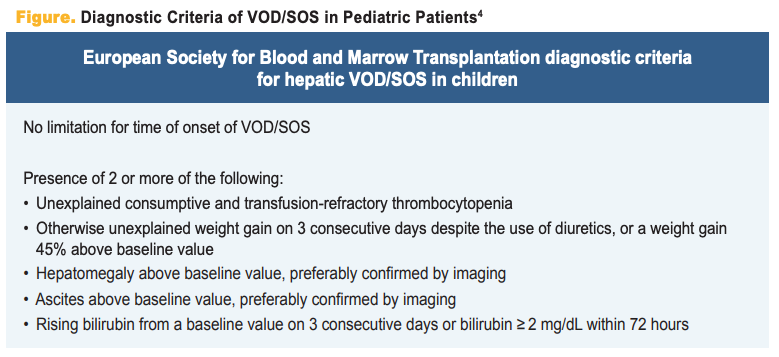Complex Cancer Cases: Veno-Occlusive Disease in a Pediatric Patient Receiving Nontransplant-Associated Chemotherapy
Veno-occlusive disease or sinusoidal obstruction syndrome is commonly associated as a complication with transplant in pediatric patients but can also be seen with chemotherapy alone.
Margaret Rabatin, DNP, FNP-BC

A 6-month-old, previously healthy male infant recently received a diagnosis of rhabdomyosarcoma, and chemotherapy was initiated. Per standard of care, he received vincristine, cyclophosphamide, and dactinomycin. On day 10 of cycle 1 of chemotherapy, he presented to the emergency department (ED) with reports of 24 hours of intractable vomiting. There were concerns about dehydration.
When he had previously received vincristine on day 8 of cycle 1, his physical exam and laboratory results were normal, with no concerning findings listed. In the ED, he appeared well; he had a normal abdominal exam and normal vital signs. A complete blood count and comprehensive metabolic panel were obtained, which together revealed that the patient had a hemoglobin level of 6.4 g/dL, along with a platelet count of 5000 × 103/μL, an alanine aminotransferase (ALT) level of 533 U/L, and an aspartate aminotransferase (AST) level of 946 U/L. His bilirubin was mildly elevated—he had a total bilirubin level of 0.07 mg/dL and direct bilirubin of 0.02 mg/dL. An abdominal x-ray was normal. He subsequently received a 20-mL/kg normal saline bolus, 0.1 mg/kg intravenous (IV) ondansetron Zofran, 1 unit of platelets, and 1 unit of packed red blood cells (PRBCs). He was admitted for dehydration and his care team performed a further workup of transaminitis. They noted that he continued to have an increase of AST/ALT, which prompted a hepatic ultrasound. The ultrasound showed markedly elevated velocity within the main hepatic artery with reversal of flow within the right portal veins. This suggested that the patient had an underlying hepatic injury—possibly veno-occlusive disease. A CT scan of the patient’s chest, abdomen, and pelvis revealed that he had moderate simple ascites as well as trace-to-moderate bilateral pleural effusions. This was likely related to the hepatic disease process.
What Is Veno-Occlusive Disease?
Veno-occlusive disease or sinusoidal obstruction syndrome (VOD/SOS) is a serious, life-threatening complication involving the liver that is commonly associated with hematopoietic stem cell transplantation (HSCT). However, VOD/SOS also can be seen in patients receiving chemotherapy alone. Numerous chemotherapy agents, including vincristine, dactinomycin, inotuzumab, and gemtuzumab ozogamicin, are associated with VOD/SOS in the non-HSCT setting.1
VOD occurs when there is damage to the hepatic sinusoidal endothelial cells, causing compression of the blood flow through the liver.1 This damage also creates a prothrombotic state that promotes platelet activation, increased fibrogenesis, and hepatic ischemia.2 Patients with VOD/SOS can develop portal hypertension, ascites, and damage to renal and pulmonary tissue. VOD/SOS can lead to multiorgan dysfunction, which is associated with a higher rate of mortality.2
Treatment
Defibrotide (Defitelio) is FDA approved for treatment of VOD/SOS in pediatric and adult patients in the United States who have undergone HSCT.2,3 Study data have shown defibrotide to promote the restoration of thrombotic-fibrinolytic balance and protect endothelial cells from further damage. Treatment is recommended for a minimum of 21 days but should continue until resolution of symptoms.3 Defibrotide should be stopped with signs or concern of hemorrhage.2 Other management considerations include closely monitoring weight, judicious use of diuretics, transfusion support, and therapeutic paracentesis for significant ascites.
Our patient met the criteria (Figure4 ) for a VOD/SOS diagnosis based on his radiologic findings and his weight gain. His AST and ALT levels peaked at 4557 U/L and 2113 U/L, respectively. He began treatment with a 6.25 mg/kg IV dose of defibrotide every 6 hours. He responded well to treatment.

A repeat ultrasound after 11 days with defibrotide treatment showed periportal echogenicity consistent with edema and appropriately directed flow. The patient’s weight was closely monitored, and he briefly received scheduled furosemide for diuresis. Throughout his hospital course, he developed impressive abdominal distention but did not require paracentesis. He received supportive transfusions with PRBCs and platelets. We continued to closely monitor him for coagulation, but he did not present any evidence of coagulopathy or bleeding throughout his hospital course.
He was discharged to home after completing a full course of defibrotide and has been able to receive additional cycles of chemotherapy without complication.
Implications for Practice
VOD/SOS is commonly associated as a complication with HSCT in pediatric patients but can also be seen with chemotherapy alone. If a patient presents with symptoms of hepatic dysfunction and has recently received chemotherapy, VOD/ SOS should be considered. Early initiation of defibrotide, in both HSCT and non-HSCT settings, is associated with better outcomes.
References
- Kernan NA, Richardson PG, Smith AR, et al. Defibrotide for the treatment of hepatic veno‐occlusive disease/sinusoidal obstruction syndrome following nontransplant‐associated chemotherapy: final results from a post hoc analysis of data from an expanded‐access program. Pediatr Blood Cancer. 2018;65(10):e27269. doi:10.1002/pbc.27269
- Kernan NA, Grupp S, Smith AR, et al. Final results from a defibrotide treatment‐IND study for patients with hepatic veno‐occlusive disease/sinusoidal obstruction syndrome. Br J Haematol. 2018;181(6):816-827. doi:10.1111/bjh.15267
- Defitelio. Prescribing information. Jazz Pharmaceuticals, Inc; 2016. Accessed May 8, 2023. https://www.accessdata.fda.gov/drugsatfda_docs/label/2016/208114lbl.pdf
- Corbacioglu S, Carreras E, Ansari M, et al. Diagnosis and severity criteria for sinusoidal obstruction syndrome/veno-occlusive disease in pediatric patients: a new classification from the European Society for Blood and Marrow Transplantation. Bone Marrow Transplant. 2018;53(2):138-145. doi:10.1038/bmt.2017.161




